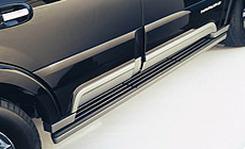It’s no secret that most of us laboring at 2002 Hogback Road scrunch our noses when handed the keys to a vehicle that weighs upwards of two-and-a-half tons. But it is also true that in 2001, 866,970 full-size SUVs that were at least so gravitationally burdened found buyers in the U.S., not to mention probably an equal quantity of similarly massive pickup trucks. In other words, big sells.
So does luxury, and when you join size and luxury, you get the Lincoln Navigator, which, since its launch as a ’98 model, has become a common fixture in America’s high-end subdivisions. Capitalism working as it does, the Navigator’s success has spawned numerous competitors, both foreign and domestic. What you see on these pages is Lincoln’s completely redesigned, second-generation Navigator, charged with the mission of maintaining Lincoln’s share in the market it had largely created.
From the outside, the new Navigator is the spit and image of the original, with the same profile, the same huge chrome-surround grille, and the same butch-looking front valance. There’s barely an inch of variation in any major dimension. Sure, the headlights are larger, and the bumper sits lower to improve crash compatibility with cars, but we suspect even current Navigator owners will not instantly recognize this as the new model.
Move inside, however, and you are overwhelmed by changes. As you crack any door on the top-of-the-line Navigator with the Ultimate package, a running board glides out from beneath the body to provide a step into the tall cockpit. Shut the door, and the running board retracts to preserve the Navigator’s smooth flanks.
Inside, the cockpit takes its cues from the elegant Lincoln Continental sedans of the early ’60s. The twin cowls of the dashboard sweep gracefully into a classy console that houses myriad controls, many of which are tucked away behind a well-damped flip-up panel. American walnut, supple leather, and a satin nickel finish provide an atmosphere of unmistakable quality, as does the white LED lighting on the minor switches and controls and the beautifully illuminated CRT instruments. Chrome is used sparingly, reserved only for the door handles and console bin latches.
Equipped with the middle-row bucket seats, our Navigator provided a supremely comfortable throne for each of the four occupants in the first two rows. Not only are the seats properly supportive, well-shaped, and equipped with recliners, but each is also surrounded by a height-adjustable shoulder-belt anchor, a jumbo-size cup holder, a useful door bin, and a humongous central console that can easily accept purses, camera bags, or a small backpack. The second-row passengers get separate controls for that zone of the climate-control system, as well as headphone jacks and audio controls. Optional is a headliner-mounted DVD entertainment system that is a hands-down favorite among children.
To get to the optional third row of seats, you fold the seatback on either of the rear buckets and then fold the entire seat forward. Access is excellent, and you end up in a vastly more comfortable third-row seat than was provided in the previous Navigator, or in any of GM’s full-size SUVs.
The secret is a new chassis with an independent rear suspension. With no need to provide room for the differential to move up and down, that space can be used for a deep footwell, allowing a normal seating posture. In contrast, in the third row of a Cadillac Escalade, your feet sit at about the same level as your behind, a posture familiar to anyone who ever sat in a Triumph TR4.
There’s a trio of three-point belts for the third row, but a triplet of normal adults will find the space a tad narrow for more than short trips. Headroom also gets tight for occupants approaching six feet. However, there’s plenty of space for kids, who are the likely consignees to row three.


Leave a Reply